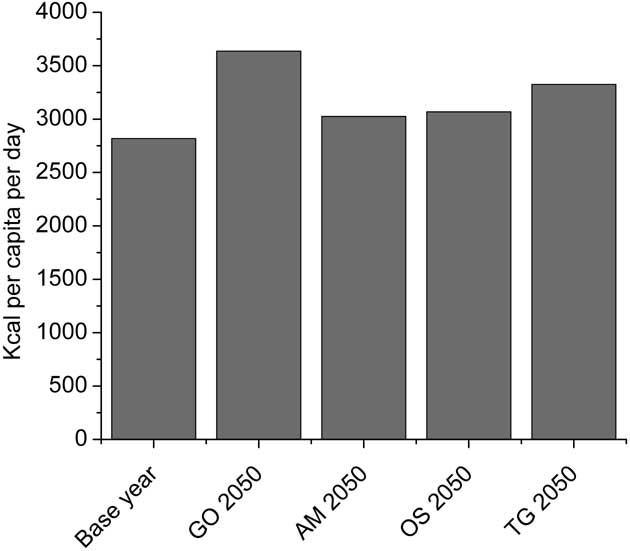
Figure 4-1 7. Average global food availability, Millennium Ecosystem Assessment Scenarios. Source: MA, 2005ab.
Notes: GO, AM, OS and TG stand for the Global Orchestration, the Adapting Mosaic, Order from Strength, and TechnoGarden Scenarios, respectively.
280 million ha in 2003, primarily in Asia (FAO, 2006c). By contrast, irrigation in sub-Saharan Africa is applied to less than 4% of the total cultivated area. The agricultural sector is expected to remain the major water user accounting for 69% of the withdrawals and 84% of the consumptive uses. Many projections agree that water will increasingly be a key constraint in food production in many developing countries, and call for the need to improve water management and increase water use efficiency (Seckler et al., 2000; Shik-lomanov, 2000; Rosegrant et al., 2002; Bruinsma, 2003; World Water Assessment Program, 2006; CA, 2007). The assessments differ in their views on the best way forward. Scenario analysis conducted as part of the Comprehensive Assessment of Water Management in Agriculture (CA, 2007) indicates that growth in global water diversions to agriculture varies anywhere between 5 and 57% by 2050 depending on assumptions regarding trade, water use efficiency, area expansion and productivity growth in rain fed and irrigated agriculture (de Fraiture et al., 2007) (Figure 4-18). Trade can help mitigate water scarcity if water-scarce countries import food from water abundant countries (Hoekstra and Hung, 2005). Cereal trade from rain fed areas in the temperate zones (USA, EU, Argentina) to arid areas (Middle East) reduces current global irrigation water demand by 11 to 13% (Oki et al., 2003, de Fraiture et al., 2004); but political and economic factors may prove stronger drivers of agricultural systems than water (de Fraiture et al., 2004).
Enhanced agricultural production from rain fed areas and higher water productivity on irrigated areas can offset the need for the development of additional water resources (Molden et al., 2000; Rosegrant et al., 2002; Rockstrom et al., 2003). However, the potential of rain fed agriculture and
the scope to improve water productivity in irrigated areas is subject to debate (Seckler et al., 2000; Rosegrant et al., 2002). Only 5% of increases in future grain production are projected to come from rain fed agriculture (Seckler et al., 2000). Over 50% of all additional grains will come from rain fed areas, particularly in developed countries, while developing countries will increasingly import grain (Rosegrant et al., 2002). Projected contribution to total global food supply from rain fed areas declines from 65% currently to 48% in 2030 (Bruinsma, 2003).
Currently, agriculture receives around 70% of total water withdrawal and accounts for 86% of consumption. Projections in growth of irrigated areas vary: 29% (Seckler et al., 2000); 24% (FAO, Bruinsma, 2003); and 12% (Rosegrant et al., 2002) (Table 4-12).The global irrigated area is expected to grow from 254 million ha in 1995 to between 280 and 350 million ha in 2025. However, towards 2050, the proportion of water used for agriculture is likely to decrease slightly, mainly at the expense of more intensive growth in other water demands such as environment, industry and public water supply. The regional water withdrawal and consumption shares for agriculture will vary as a function of stage of industrialization, climate and other management and governance factors. In many water scarce areas current per capita water consumption is unsustainable. Globally, water is sufficient to produce food for a growing and wealthier population, but continuance with today's water management practices will lead to many acute water crises in many parts of the world (CA, 2007).
While major tradeoffs will occur between all water using sectors, they will be particularly pronounced between agriculture and the environment as the two largest water demanding sectors (Rijsberman and Molden, 2001). Signs of severe environmental degradation because of water scarcity, overabstraction and water pollution are apparent in a growing number of places and the adverse impacts of irrigation on ecosystems services other than food production are well documented (Pimentel and Wilson, 2004; MA, 2005a; Khan et al., 2006; CA, 2007). Reduction in ecosystem services often has severe consequences for the poor, who depend heavily on ecosystems for their livelihoods (Falkenmark et al., 2007). Aquifer depletion and groundwater pollution threaten the livelihoods of millions of small-scale farmers in South Asia; in response, various local initiatives to recharge groundwater and stop overuse have been developed (Shah et al., 2007).
4.4.2.2 Soils and fertilizers
Sustainable management of soil is vital to agricultural productivity and food security. Among the many driving forces that will affect soils and their utility in sustaining world agriculture are population growth, land use planning and policies, land development and growth and demands for agricultural products (Blum, 2001). These driving factors operate directly and interact in different ways to produce positive (sustainability) and negative effects (degradation) on soil. Soil degradation due to improper farming practices has had more devastating effects on soil quality in many developing countries than the industrialized world. While demand for food has risen with increasing population, the present productivity from the arable land of the developing